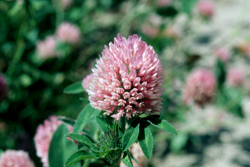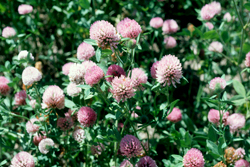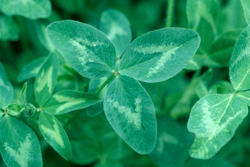Oregon-Grown Clover Seed
Oregon is the source of world class clover seed for pasture, cover crops or simply for beautification around the house.
- Attracts Beneficial Insects
- Reduced Animal Toxicities
- Healthier Soil
- Lower Nitrogen Fertilizer Costs
Red CloverRed clover is an important forage legume grown in temperate regions throughout the world. It is believed to have originated in southeastern Europe near the Mediterranean Sea, and was grown in Europe in the third and fourth centuries. It was introduced into the USA by European colonists in the late 1600's. Red Clover BenefitsRed clover benefits include its adaptability to a wide range of climatic conditions, soil types, fertility levels, use patterns and management. Other red clover benefits include being easy to establish, having high seedling vigor, acting as an excellent nitrogen fixer, being free from many disease and insect pests, having versatile uses, and being suitable for use in rotations. Although red clover is tolerant of a wide range of soil and climatic conditions, it is best suited where summer temperatures are moderately cool to warm and soil moisture is available throughout the growing season. 
Red clover is a perennial. In the Willamette Valley, it is commonly planted in the spring, but may also be planted in August or September, especially if the grower can irrigate. Growers harvest the spring red clover seed in late summer. In late May, the plants start to bloom, but growers cut the fields for forage around this time. The purpose is to delay the bloom so that all the flowers come at the same time. Most growers sell the forage as green chop to dairies. Even if a grower does not sell the forage, the field will be clipped or mowed, because a uniform bloom is important for seed production. red clover seed is harvested in August and September. 
Native bumble bees are known to be better pollinators of red clover than honey bees. Honey bees, with a shorter proboscis, can not reach the nectar in the long flowers of red clover, so they will go to other flowers if available. Since bumble bees nest in the ground, it is to a grower's advantage to leave some wild areas near the field for habitat. Honeybees can still help seed yield, and many growers contract with beekeepers to place hives in their fields. Aphids are a problem in red clover that usually requires treatment with insecticide once a season, before the bloom to avoid killing bees. Aphids may reduce seed yields, but a worse problem is created by the sticky honeydew aphids produce. Seeds covered with honeydew are difficult to harvest and clean. A red clover stand usually lasts for only one or two seed crops. The reason is the clover root borer (Hylastinus obscurus). This bark beetle is the limiting factor in red clover production in the Willamette Valley. The adult lays eggs in the crown of the plant. The larvae mine out channels in the roots, which then become a site for infection with root rot fungus (Fusarium solani). Plants are weakened, and the seed yield drops in the second year. A third year of seed production is not economical. There is no control for clover root borer other than rotation. 
When June rainfall is lower than usual, the seed yield of red clover can be improved by irrigation at early flowering. Normally a healthy first-year stand with little root borer damage can produce a maximum yield with no irrigation. Improved varieties of red clover yield less seed than the common type (Medium Red), so forage producers should expect seed of improved varieties to cost more. The right improved variety, however, can yield more forage and be more than worth the extra cost of seed. Oregon Clover CommissionUniversity of KentuckyForage Identification and Use Guide - Red Clover |